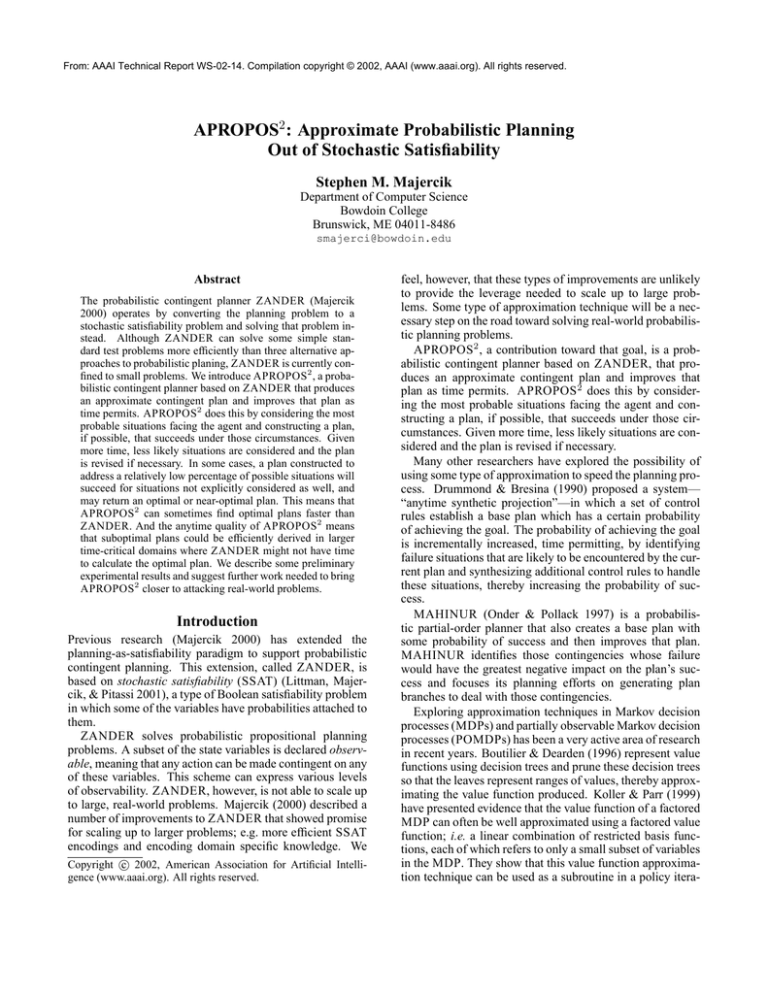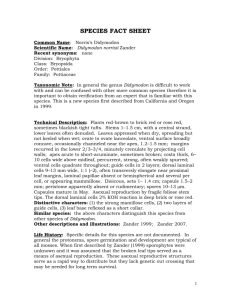
From: AAAI Technical Report WS-02-14. Compilation copyright © 2002, AAAI (www.aaai.org). All rights reserved.
APROPOS2 : Approximate Probabilistic Planning
Out of Stochastic Satisfiability
Stephen M. Majercik
Department of Computer Science
Bowdoin College
Brunswick, ME 04011-8486
smajerci@bowdoin.edu
Abstract
The probabilistic contingent planner ZANDER (Majercik
2000) operates by converting the planning problem to a
stochastic satisfiability problem and solving that problem instead. Although ZANDER can solve some simple standard test problems more efficiently than three alternative approaches to probabilistic planing, ZANDER is currently confined to small problems. We introduce APROPOS2 , a probabilistic contingent planner based on ZANDER that produces
an approximate contingent plan and improves that plan as
time permits. APROPOS2 does this by considering the most
probable situations facing the agent and constructing a plan,
if possible, that succeeds under those circumstances. Given
more time, less likely situations are considered and the plan
is revised if necessary. In some cases, a plan constructed to
address a relatively low percentage of possible situations will
succeed for situations not explicitly considered as well, and
may return an optimal or near-optimal plan. This means that
APROPOS2 can sometimes find optimal plans faster than
ZANDER. And the anytime quality of APROPOS2 means
that suboptimal plans could be efficiently derived in larger
time-critical domains where ZANDER might not have time
to calculate the optimal plan. We describe some preliminary
experimental results and suggest further work needed to bring
APROPOS2 closer to attacking real-world problems.
Introduction
Previous research (Majercik 2000) has extended the
planning-as-satisfiability paradigm to support probabilistic
contingent planning. This extension, called ZANDER, is
based on stochastic satisfiability (SSAT) (Littman, Majercik, & Pitassi 2001), a type of Boolean satisfiability problem
in which some of the variables have probabilities attached to
them.
ZANDER solves probabilistic propositional planning
problems. A subset of the state variables is declared observable, meaning that any action can be made contingent on any
of these variables. This scheme can express various levels
of observability. ZANDER, however, is not able to scale up
to large, real-world problems. Majercik (2000) described a
number of improvements to ZANDER that showed promise
for scaling up to larger problems; e.g. more efficient SSAT
encodings and encoding domain specific knowledge. We
c 2002, American Association for Artificial IntelliCopyright gence (www.aaai.org). All rights reserved.
feel, however, that these types of improvements are unlikely
to provide the leverage needed to scale up to large problems. Some type of approximation technique will be a necessary step on the road toward solving real-world probabilistic planning problems.
APROPOS2 , a contribution toward that goal, is a probabilistic contingent planner based on ZANDER, that produces an approximate contingent plan and improves that
plan as time permits. APROPOS2 does this by considering the most probable situations facing the agent and constructing a plan, if possible, that succeeds under those circumstances. Given more time, less likely situations are considered and the plan is revised if necessary.
Many other researchers have explored the possibility of
using some type of approximation to speed the planning process. Drummond & Bresina (1990) proposed a system—
“anytime synthetic projection”—in which a set of control
rules establish a base plan which has a certain probability
of achieving the goal. The probability of achieving the goal
is incrementally increased, time permitting, by identifying
failure situations that are likely to be encountered by the current plan and synthesizing additional control rules to handle
these situations, thereby increasing the probability of success.
MAHINUR (Onder & Pollack 1997) is a probabilistic partial-order planner that also creates a base plan with
some probability of success and then improves that plan.
MAHINUR identifies those contingencies whose failure
would have the greatest negative impact on the plan’s success and focuses its planning efforts on generating plan
branches to deal with those contingencies.
Exploring approximation techniques in Markov decision
processes (MDPs) and partially observable Markov decision
processes (POMDPs) has been a very active area of research
in recent years. Boutilier & Dearden (1996) represent value
functions using decision trees and prune these decision trees
so that the leaves represent ranges of values, thereby approximating the value function produced. Koller & Parr (1999)
have presented evidence that the value function of a factored
MDP can often be well approximated using a factored value
function; i.e. a linear combination of restricted basis functions, each of which refers to only a small subset of variables
in the MDP. They show that this value function approximation technique can be used as a subroutine in a policy itera-
In this section, we provide a brief overview of ZANDER.
Details are available elsewhere (Majercik 2000). ZANDER works on partially observable probabilistic propositional planning domains consisting of a finite set of distinct
propositions, any of which may be true or false at any
discrete time t. A state is an assignment of truth values to
these propositions. A possibly probabilistic initial state is
specified by a set of decision trees, one for each proposition.
Goal states are specified by a partial assignment to the set of
propositions; any state that extends this partial assignment is
a goal state. Each of a finite set of actions probabilistically
transforms a state at time t into a state at time t + 1 and so
induces a probability distribution over the set of all states.
A subset of the set of propositions is the set of observable
propositions. The task is to find an action for each step t as a
function of the value of observable propositions for steps before t and that maximizes the probability of reaching a goal
state.
ZANDER uses a propositional problem representation
called the sequential-effects-tree representation (ST), which
is a syntactic variant of two-time-slice Bayes nets (2TBNs)
with conditional probability tables represented as trees (Majercik 2000). In the ST representation, each action a is represented by an ordered list of decision trees, the effect of a
on each proposition represented as a separate decision tree.
This ordering means that the tree for one proposition can
refer to old and new values of previous propositions, thus
allowing the effects of an action to be correlated. The leaves
of a decision tree describe how the associated proposition
changes as a function of the state and action, perhaps probabilistically.
ZANDER converts the ST representation of the problem into a stochastic satisfiability (SSAT) problem. An
SSAT problem is a satisfiability (SAT) problem, assumed
to be in conjunctive normal form, with two types of
Boolean variables—termed choice variables and chance
variables (Majercik 2000)—and an ordering specified for
the variables. A choice variable is like a variable in a regular SAT problem; its truth value can be set by the planning agent. Each chance variable, on the other hand, has an
independent probability associated with it that specifies the
probability that that variable will be true.
R
ZANDER
These probabilities, in the general case, make it impossible to satisfy the SSAT formula with certainty, and the challenge is to select values for the choice variables that maximize the probability of satisfaction. This can be complicated by the ordering of the variables. In the simplest type of
SSAT problem containing both types of variables, all of the
choice variables come first in the ordering, and the problem
is to select values of the choice variables such that the probability of getting a satisfying assignment is maximized with
respect to the chance variables. But, in the type of SSAT
problem used by ZANDER to encode contingent planning
problems, groups of choice variables and chance variables
alternate in the variable ordering.
Choice variables can be thought of as being existentially
quantified—we must pick a single, best value for such a
variable—while chance variables can be thought of as “randomly” quantified—they introduce uncontrollable random
variation which, in general, makes it more difficult to find
a satisfying assignment. So, for example, an SSAT formula
with the ordering ∃v w∃x y∃z asks for values of v, x (as
a function of w), and z (as a function of w and y) that maximize the probability of satisfaction given the independent
probabilities associated with w and y. This dependence of
choice variable values on the earlier chance variable values
in the ordering allows ZANDER to map contingent planning problems to stochastic satisfiability.
The variables in an SSAT plan encoding fall into three
segments (Majercik 2000): a plan-execution history, the domain uncertainty, and the result of the plan-execution history
given the domain uncertainty. The plan-execution-history
segment is an alternating sequence of choice-variable blocks
(one for each action choice) and chance-variable blocks (one
for each set of possible observations at a time step). The domain uncertainty segment is a single block containing all the
chance variables that modulate the impact of the actions on
the observation and state variables. The result segment is
a single block containing all the non-observation state variables. Essentially, ZANDER must find an assignment tree
that specifies the optimal action choice-variable assignment
given all possible settings of the observation variables (Majercik 2000).
The solver does a depth-first search of the tree of all possible truth assignments, constructing a solution subtree by
calculating, for each variable node, the probability of a satisfying assignment given the partial assignment so far. For a
choice variable, this is the maximum probability of its children. For a chance variable, the probability will be the probability weighted average of the success probabilities for that
node’s children. The solver finds the optimal plan by determining the subtree that yields the highest probability at the
root node.
ZANDER uses unit propagation (assigning a variable in a
unit clause—a clause with a single literal—its forced value)
and, to a much lesser extent, pure variable assignment (assigning the appropriate truth value to a choice variable that
appears only positively or only negatively) to prune subtrees in this search. Also, although the order in which variables are considered is constrained by the SSAT-imposed
variable ordering, where there is block of similar (choice
R
tion process to solve factored MDPs (Koller & Parr 2000).
Kearns, Mansour, & Ng (1999) describe a method for choosing, with high probability, approximately optimal actions in
an infinite-horizon discounted Markov decision process using truncated action sequences and random sampling. Zhang
& Lin (1997) transform a POMDP into a simpler region observable POMDP in which it is assumed an oracle tells the
agent what region its current state is in. This POMDP is
easier to solve and they use its solution to construct an approximate solution for the original POMDP.
In the next section we briefly describe ZANDER. We
then describe the APROPOS2 algorithm for approximate
planning and describe some preliminary experimental results. We conclude with some suggestions for further work.
or chance) variables with no imposed ordering, ZANDER
considers those with the earliest time index first. This
TIME ORDERED heuristic takes advantage of the temporal structure of the clauses induced by the planning problem to produce more unit clauses. ZANDER also uses dynamically calculated success probability thresholds to prune
branches of the tree. (e.g. if the best possible success probability of a particular branch is less than the current best
success probability). We are currently working on incorporating learning to improve ZANDER’s performance.
APROPOS2
Before we describe APROPOS2 it is worth looking at a previous approach to approximation in this framework (Majercik 2000). This approach illuminates some of the problems
associated with formulating an approximation algorithm in
this framework and explains some of the choices we made
in developing APROPOS2 .
Majercik (2000) describes an algorithm called
RANDEVALSSAT that uses stochastic local search in
a reduced plan space. RANDEVALSSAT uses random
sampling to select a subset of possible chance variable
instantiations (thus limiting the size of the contingent plans
considered) and stochastic local search to find the best
size-bounded plan.
As Majercik (2000) point out, there are two problems with
this approach. First, since chance variables are used to describe observations, a random sample of the chance variables describes an observation sequence as well as an instantiation of the uncertainty in the domain, and the observation
sequence thus produced may not be observationally consistent, and these inconsistencies can make it impossible to find
a plan, even if one exists. Second, this algorithm returns a
partial policy, that specifies actions only for those situations
represented by paths in the random sampling of chance variables.
APROPOS2 addresses these two problems by:
• designating each observation variable as a special type of
variable, termed a branch variable, rather than a chance
variable, and
• evaluating the approximate plan’s performance under all
circumstances, not just those used to generate the plan.
The introduction of branch variables violates the pure SSAT
form of the plan encoding, but is justified, we think, for
the sake of conceptual clarity. We could achieve the same
end in the pure SSAT form by making observation variables
chance variables (as Majercik (2000) does), and not including them when the possible chance-variable assignments are
enumerated. But, rather than taking this circuitous route,
we have chosen to acknowledge the special role played by
observation variables; these variables indicate a potential
branch in a contingent plan (hence the name). As such,
the value of an observation variable node in the assignment
tree described above is the sum of the values of its children.
This introduces a minor modification into the ZANDER approach and has the benefit of clarifying the role of the observation variables.
The operation of APROPOS2 can be summarized as follows:
1. Enumerate some fraction of the possible assignments to
the chance variables starting with the most probable and
continuing in decreasing order of probability.
2. Calculate, for each chance-variable assignment, all the
action-observation paths that are consistent with the
chance variable assignment (lead to a satisfying assignment).
3. Increase the weight of each of the consistent actionobservation paths by the probability of the chancevariable assignment.
4. Extract the best plan by finding the tree of actionobservation paths that has the highest weight and whose
observations are consistent (note that this weight is a
lower bound on the true probability of success of the plan
embodied in the tree).
5. Evaluate the full assignment tree given the extracted plan
in order to determine the true success probability of the
plan.
This basic framework is easily modified to produce an
anytime algorithm. One way to think about this is that we are
incrementally constructing the optimal action-observation
tree by building up the probabilities as we process the possible instantiations of the chance variables. We can stop the
approximation process after any number of chance variable
assignments have been considered and extract and evaluate the best plan for the chance-variable assignments that
have been considered so far. If the probability of success of
this plan is sufficient (probability 1.0 or exceeding a userspecified threshold), the algorithm halts and return the plan
and probability; otherwise, APROPOS2 continues processing chance variable assignments. Note also that the probability of success of the just-extracted plan can now be used as
a new lower threshold in subsequent plan evaluations, often
allowing additional pruning to be done. The quality of the
plan produced increases (if the optimal success probability
has not already been attained) with the available computation time.
Because the chance variable instantiations are investigated in descending order of probability, it is likely that a
plan with a relatively high percentage of the optimal success
probability will be found quickly. One of the exceptions
here is the situation in which the high probability situations
are hopeless and the best that can be done is to construct a
plan that addresses some number of lower probability situations. Even here, the basic SSAT heuristics used will allow APROPOS2 to quickly discover that no plan is possible for the high-probability situations, and lead it to focus
on the low-probability situations for which a plan is feasible. Of course, if all chance-variable assignments are considered, the plan extracted is the optimal plan, but, as we
shall see, the optimal plan may sometimes be produced even
after only a relatively small fraction of the chance-variable
assignments have been considered.
This approach may seem counter-intuitive. Instead of
instantiating all the chance variables, wouldn’t it make
more sense to instantiate chance variables based on the
instantiation of variables (particularly action variables) at
previous times steps? For example, given the action
choice made at the first time step, what is the most likely
instantiation of chance variables facing the agent now?
This type of approach mirrors the operation of ZANDER
much more closely—searching the SSAT tree of possible
assignments—except that the search is speeded up by considering only the more likely chance variable instantiations.
This would seem to require a significant amount of overhead to keep track of which choices have been made and,
in most cases, would entail the repeated solving of a number of SSAT subproblems with one or more chance variable
settings changed.
The APROPOS2 approach seeks to accomplish a similar
goal in a different way. By enumerating complete instantiations of the chance variables in descending order of probability, APROPOS2 is choosing the most likely outcomes
of all actions at all time steps. Because it is not taking variable independencies into account, it does so somewhat inefficiently. At the same time, however, by instantiating all
the chance variables at the same time, APROPOS2 reduces
the SSAT problem to a much simpler SAT problem. Although this approach will also entail the repeated solving of
a number of subproblems with one or more chance variable
settings changed, the conjecture is that solving a large number of SAT problems will take less time than solving a large
number if SSAT problems. Obviously, this will depend on
the relative number of problems involved, but we have chosen to explore the approach embodied in APROPOS2 first.
In the current implementation of APROPOS2 , the user
specifies the total number of chance-variable assignments to
be considered, the interval at which the current plan should
be extracted and evaluated (the default is 5% of the total
number of chance-variable assignments being considered),
and optional lower and upper success probability thresholds.
If the algorithm finds a plan that meets or exceeds the upper
success probability threshold, it halts and returns that plan.
All of the operations in APROPOS2 can be performed
as or more efficiently than the operations necessary in the
ZANDER framework.
1. Enumerate: The chance variable instantiations can be
generated in descending order in time linear in the number
of instantiations using a priority queue.
2. Calculate: Finding all consistent action-observation paths
amounts to a depth-first search of the assignment tree
checking for satisfiability using pruning heuristics (the
central operation of ZANDER). Note also that once an
action-observation path is instantiated, checking whether
it can be extended to a satisfying assignment amounts to
a series of fast unit propagations.
In fact, once the chance variables have all been set, the remaining variables are all choice variables and the search
for all action-observation paths that lead to satisfying
assignments can be accomplished by any efficient SAT
solver that finds all satisfying assignments. In particular, this opens up the possibility for using a better splitting heuristic. We tested a number of different heuris-
tics: choosing a variable randomly, finding the literal that
satisfies the most clauses in the current formula, 2-sided
Jeroslow-Wang (Hooker & Vinay 1995), positive, 2-sided
Jeroslow-Wang (Hooker & Vinay 1995), choosing the
variable that has “Maximum Occurrences in clauses of
Minimum Size” (MOMS) and MAX UNIT (Bayardo &
Schrag 1997), which is similar to heuristics used by the
successful POSIT (Freeman 1995) and TABLEAU (Crawford & Auton 1996) solvers, preferring variables that will
lead to a maximal number of unit propagations. Preliminary tests indicate that the TIME ORDERED heuristic used by ZANDER (Majercik 2000) usually performs
better than any of these heuristics, probably because this
ordering takes advantage of the structure provided by the
temporal ordering of the clauses and induces more unit
propagations (i.e. setting the variables at time step t tends
to force the values of variables at time step t + 1)
3. Increase: A simple addition.
4. Extract: A simple depth-first search of the actionobservation tree suffices; this is sped up further by the
fact that satisfiability does not have to be checked (having
been taken care of in the calculate phase).
5. Evaluate: A depth-first search of the entire assignment
tree is necessary, but heuristics speed up the search, and
the resulting probability of success can be used as a lower
threshold if the search continues, thus possibly speeding
up subsequent computation.
Results
Preliminary results are mixed but indicate that APROPOS2
has some potential as an approximation technique. In some
cases, it outperforms ZANDER, in spite of the burden of the
additional approximation machinery. And, in those cases,
where its performance is poorer, there is potential for further
performance improvements (see Further Work).
We tested APROPOS2 on three domains that ZANDER
was tested on (Majercik 2000). The HUNGRY-TIGER
problem contains uncertain initial conditions and a noisy observation; the agent needs the entire observation history in
order to act correctly. The COFFEE-ROBOT problem is
a larger problem (7 actions, 2 observation variables, and 8
state propositions in each of 6 time steps) with uncertain initial conditions, but perfect causal actions and observations.
Finally, the GENERAL-OPERATIONS problem has no
uncertainty in the initial conditions, but requires that probabilistic actions be interleaved with perfect observations. All
experiments were conducted on an 866 MHz Dell Precision
620 with 256 Mbytes of RAM, running Linux 7.1.
In the 4-step HUNGRY-TIGER problem, ZANDER
found the optimal plan (0.93925 probability of success) in
0.01 CPU seconds. APROPOS2 requires 0.42 CPU seconds to find the same plan (extracting and evaluating the current plan after every 5% of chance variable instantiations).
This is, however, if we insist on forcing APROPOS2 to
look for the best possible plan (and, thus, to process all 512
chance variable instantiations), which seems somewhat out
of keeping with the notion of APROPOS2 as an approximation technique. If we run APROPOS2 on this problem
Domain
4-step
HUNGRYTIGER
6- STEP
COFFEEROBOT
7- STEP
GENERALOPERATIONS
Number
of Chance
Variable
Instantiations
1
2
3
4
5
6
7
8
9
10
11
12
13
14
15
16
17
18
1
2
3
4
1
2
3
4
5
6
7
8
9
10
11
12
13
14
15
16
17
18
19
20
Time
in
CPU
Seconds
0.0
0.0
0.0
0.0
0.01
0.01
0.01
0.01
0.01
0.01
0.01
0.01
0.01
0.01
0.01
0.02
0.02
0.02
2.24
4.98
9.12
15.07
1.06
1.20
1.51
1.74
1.98
2.17
2.47
2.67
2.92
3.07
3.36
3.62
3.83
4.03
4.26
4.47
4.83
4.97
5.16
5.44
Probability
of
Plan
Success
0.307062
0.614125
0.614125
0.668312
0.668312
0.722500
0.722500
0.722500
0.776687
0.776687
0.830875
0.830875
0.885062
0.885062
0.885062
0.885062
0.885062
0.939250
0.5
0.5
1.0
1.0
0.125
0.125
0.125
0.125
0.125
0.125
0.125
0.125
0.125
0.125
0.1875
0.1875
0.1875
0.1875
0.1875
0.1875
0.1875
0.1875
0.25
0.25
Table 1: The probability of success increases with the number of chance variable instantiations considered.
under similar assumptions, but specify a success probability
threshold of 0.90 (we will accept any plan with a success
probability of 0.90 or higher), APROPOS2 returns a plan
in 0.02 CPU seconds. The plan returned is, in fact, the optimal plan, and is found after examining the first 18 chance
variable instantiations.
Table 1 provides an indication of what kind of approximation would be available if less time were available than what
would be necessary to compute the optimal plan. This table
shows how computation time and probability of plan success
increases with the number of chance variable instantiations
considered until the optimal plan is reached at 18 chancevariable instantiations.
The 6-step COFFEE-ROBOT problem provides an interesting counterpoint to the HUNGRY-TIGER problem in
that APROPOS2 does better than ZANDER. ZANDER
is able to find the optimal plan (success probability 1.0) in
19.34 CPU seconds, while APROPOS2 can find the same
plan in 9.12 CPU seconds. There are only 4 chance variable instantiations in the COFFEE-ROBOT problem and,
since extraction and evaluation of the plan at intervals of 5%
would result in intervals of less than one, the algorithm defaults to extracting and evaluating the plan after each chance
variable instantiation is considered. Although one might
conjecture that this constant plan extraction and evaluation
is a waste of time, in this case it leads to the discovery of an
optimal plan (success probability of 1.0) after processing the
first 3 chance variable instantiations, and the resulting solution time of 9.12 CPU seconds (including plan extraction
and evaluation time) is less than the solution time if we force
APROPOS2 to wait until all four chance variable instantiations have been considered before extracting and evaluating
the best plan (15.07 CPU seconds).
This illustrates an interesting tradeoff. In the latter case,
although APROPOS2 is not “wasting” time extracting and
evaluating the plan after each chance variable instantiation
(doing it once instead of three times), it does an extra chance
variable instantiation, and this turns out to take more time
than the extra plan extraction and evaluations. This is not
surprising since checking a chance variable instantiation involves solving a SAT problem to find all possible satisfying assignments, while extracting and evaluating the plan
is straightforward depth-first search. This suggests that we
should be biased toward more frequent plan extraction and
evaluation; more work is needed to determine if some optimal frequency can be automatically determined for a given
problem. Table 1 provides an indication of how computation time and probability of plan success increases with
the number of chance variable instantiations considered for
the COFFEE-ROBOT problem. Interestingly, although the
probability mass of the chance variables is spread uniformly
across the four chance variable instantiations, APROPOS2
is still able to find the optimal plan without considering all
the chance variable instantiations.
The 7-step GENERAL-OPERATIONS problem shows
us that this not necessarily the case, especially when, as in
the GENERAL-OPERATIONS problem, the probability
mass is spread uniformly over many more (221 = 2097152)
chance variable instantiations. In this problem, ZANDER is
able to find the optimal plan (success probability 0.773437)
in 2.48 CPU seconds. Because of the large number of chance
variable instantiations to be processed, APROPOS2 cannot even approach this speed. APROPOS2 needs about
566 CPU seconds to process only 3000 (0.14%) of the total
chance variable instantiations, yielding a plan with success
probability of 0.648438. Table 1 provides an indication of
how computation time and probability of plan success increases with the number of chance variable instantiations
considered for the GENERAL-OPERATIONS problem.
As the size of the problem increases, however, to the
point where ZANDER might not be able to return an optimal plan in sufficient time, APROPOS2 may be useful if it can return any plan with some probability of success in less time than it would take ZANDER to find the
optimal plan. We tested this conjecture on the 10-step
GENERAL-OPERATIONS problem (230 = 1073741824
chance variable instantiations). Here, ZANDER needed
405.35 CPU seconds to find the optimal plan (success probability 0.945313). APROPOS2 was able to find a plan in
somewhat less time (324.92 CPU seconds to process 20
chance variable instantiations), but this plan has a success
probability of only 0.1875.
Further Work
We need to improve the efficiency of APROPOS2 if it is to
be a viable approximation technique, and there are a number of techniques we are in the process of implementing that
should help us to achieve this goal. First, we are implementing an incremental approach: every time a new actionobservation path is added, APROPOS2 would incorporate
that path into the current plan, checking to see if it changes
that plan by checking values stored in that path from that
point to the root. Whenever this process indicates that the
plan has changed, the plan extraction and evaluation process
will be initiated.
Second, when APROPOS2 is processing the chance variable instantiations in descending order, in many cases the
difference between two adjacent instantiations is small. We
can probably take advantage of this to find the actionobservation paths that satisfy the new chance variable instantiation more quickly.
Third, since we are repeatedly running a SAT solver to
find action-observation paths that lead to satisfying assignments for the chance-variable assignments, and since two
chance variable assignments will frequently generate the
same satisfying action-observation path, it seems likely that
we could speed up this process considerably by incorporating learning into APROPOS2 .
Finally, we are investigating whether plan simulation (instead of exact calculation of the plan success probability)
would be a more efficient way of evaluating the current plan.
References
Bayardo, Jr., R. J., and Schrag, R. C. 1997. Using CSP
look-back techniques to solve real-world SAT instances. In
Proceedings of the Fourteenth National Conference on Artificial Intelligence, 203–208. AAAI Press/The MIT Press.
Boutilier, C., and Dearden, R. 1996. Approximating value
trees in structured dynamic programming. In Saitta, L., ed.,
Proceedings of the Thirteenth International Conference on
Machine Learning.
Crawford, J. M., and Auton, L. D. 1996. Experimental
results in the crossover point in random 3SAT. Artificial
Intelligence 81(1-2):31—57.
Drummond, M., and Bresina, J. 1990. Anytime synthetic
projection: Maximizing the probability of goal satisfaction.
In Proceedings of the Eighth National Conference on Artificial Intelligence, 138–144. Morgan Kaufmann.
Freeman, J. W. 1995. Improvements to propositional satisfiability search algorithms. Ph.D. Dissertation, Department
of Computer and Information Science, University of Pennsylvania.
Hooker, J. N., and Vinay, V. 1995. Branching rules for
satisfiability. Journal of Automated Reasoning 15(3):359–
383.
Kearns, M. J.; Mansour, Y.; and Ng, A. Y. 1999. A
sparse sampling algorithm for near-optimal planning in
large markov decision processes. In IJCAI, 1324–1231.
Koller, D., and Parr, R. 1999. Computing factored value
functions for policies in structured MDPs. In Proceedings
of the Sixteenth International Joint Conference on Artificial
Intelligence, 1332–1339. The AAAI Press/The MIT Press.
Koller, D., and Parr, R. 2000. Policy iteration for factored
MDPs. In Proceedings of the Sixteenth Annual Conference
on Uncertainty in Artificial Intelligence (UAI 2000).
Littman, M. L.; Majercik, S. M.; and Pitassi, T. 2001.
Stochastic Boolean satisfiability. Journal of Automated
Reasoning 27(3):251—296.
Majercik, S. M. 2000. Planning Under Uncertainty via
Stochastic Satisfiability. Ph.D. Dissertation, Department
of Computer Science, Duke University.
Onder, N., and Pollack, M. E. 1997. Contingency selection
in plan generation. In Proceedings of the Fourth European
Conference on Planning.
Zhang, N. L., and Lin, W. 1997. A model approximation
scheme for planning in partially observable stochastic domains. Journal of Artificial Intelligence Research 7:199–
230.






